|
Posted: 8/4/2009 4:30:04 PM EDT
This is my antique that I have owned since 1986. I original got as a gift along with a Remington 1000 that had severe water damaged from a flooded cellar and then the gun collection was ignored for months. The owner gave them to me for salvaging part of the lot. He was gone away on business when the flood happened. Unfortuneately the boxes were destroyed and thrown away by his brother. One wooden box for an antique qas being used as a socket box in his brothers car.
BTW. it was given to me because it was rusted to the point of being mechanically frozen.( (BTW.. the 100 still had a round in it from the brother testing it. It was really jammed in. May have to change steel seals. Having problems lately cycling thru after firing. Jams.) After removing the wood, I soaked it in Miracle oil for a couple of weeks. I cleand it up the best that I could. I'm having problems identifying the manufacturer, year, and model . 7mm Pinfire Fist Revolver by Deprez, Delhaxhe(Liège Belgium) or Lefaucheux(French ) DEPREZ http://www.littlegun.be/arme%20belge/artisans%20identifies%20den/a%20deprez%20gb.htm DELHAXHE http://www.littlegun.be/arme%20belge/artisans%20identifies%20d/a%20delhaxe%20gb.htm LEFAUCHEUX (Waiting to find a good link) My Antique is 7mm Pinfired Fluted 6-Shot Cylinder smooth bore Double Action with folding trigger Black Walnut Grips original finish knurled not smooth 7mm Pinfired Note the damged cylinder mount. 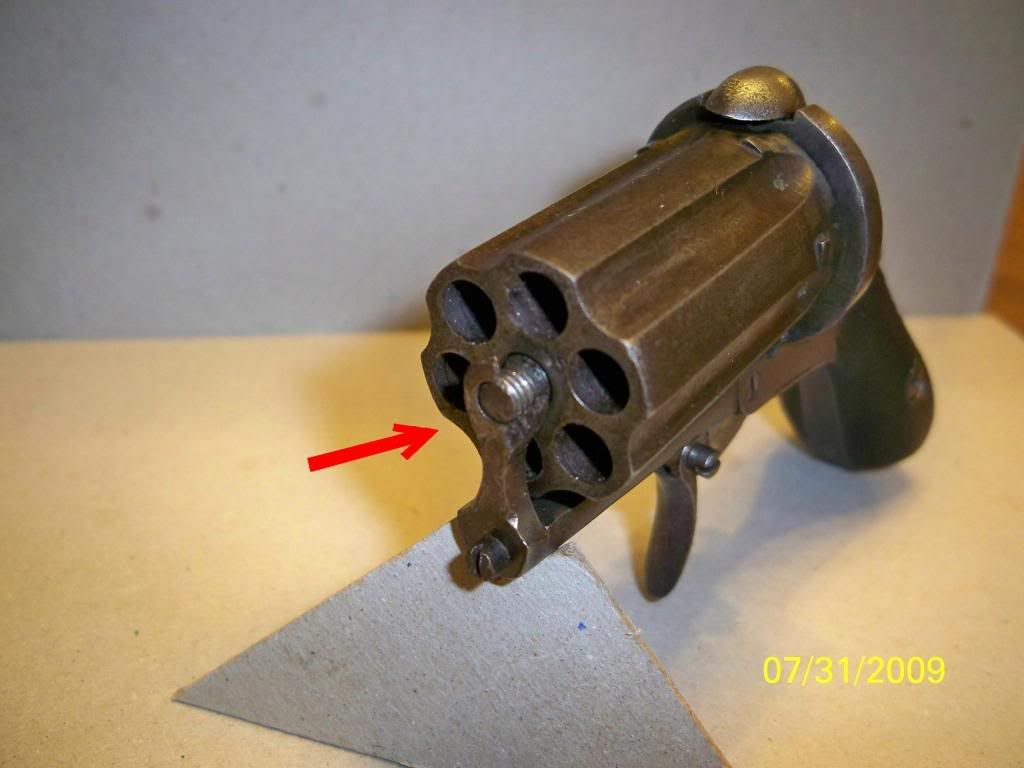
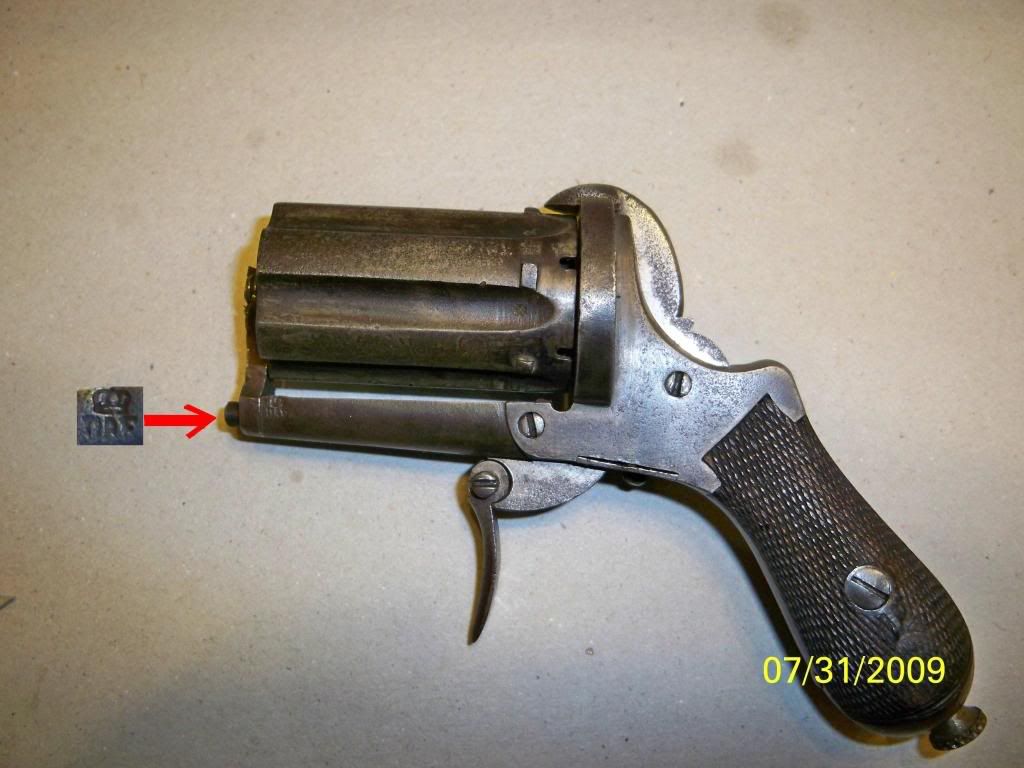
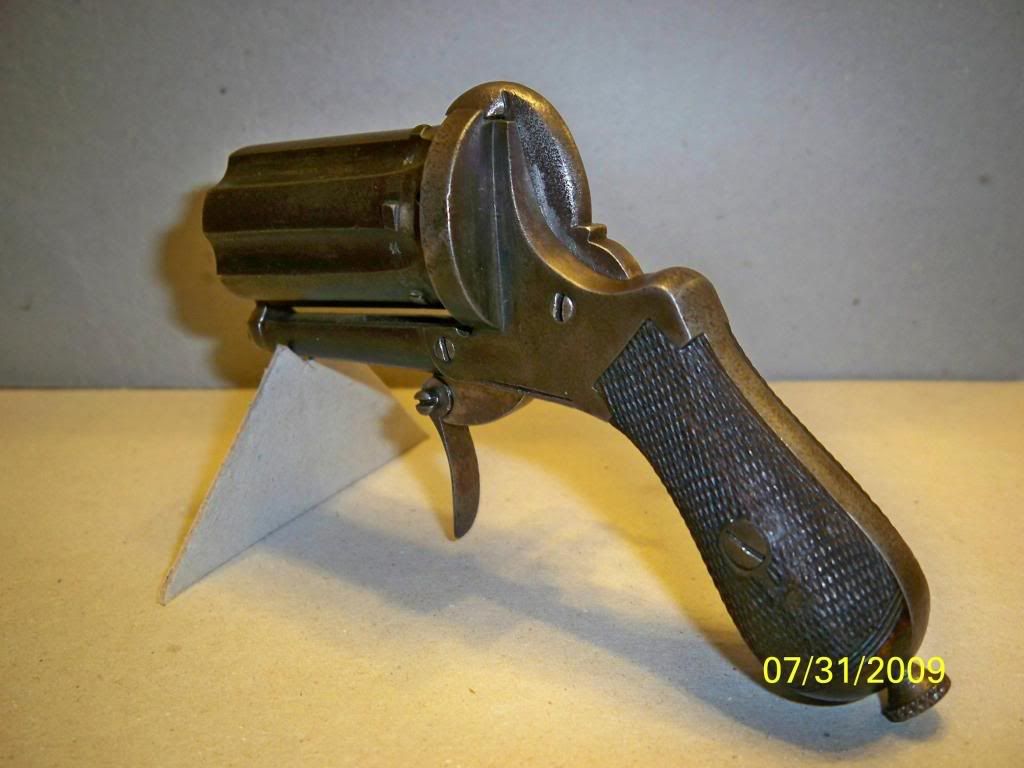
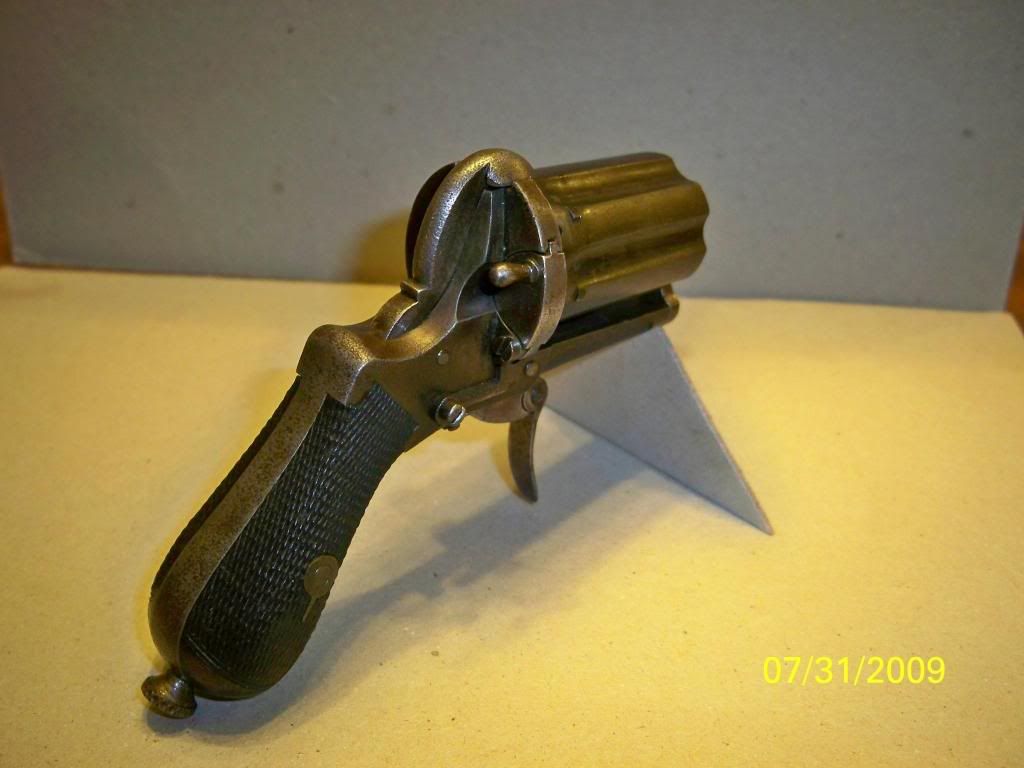
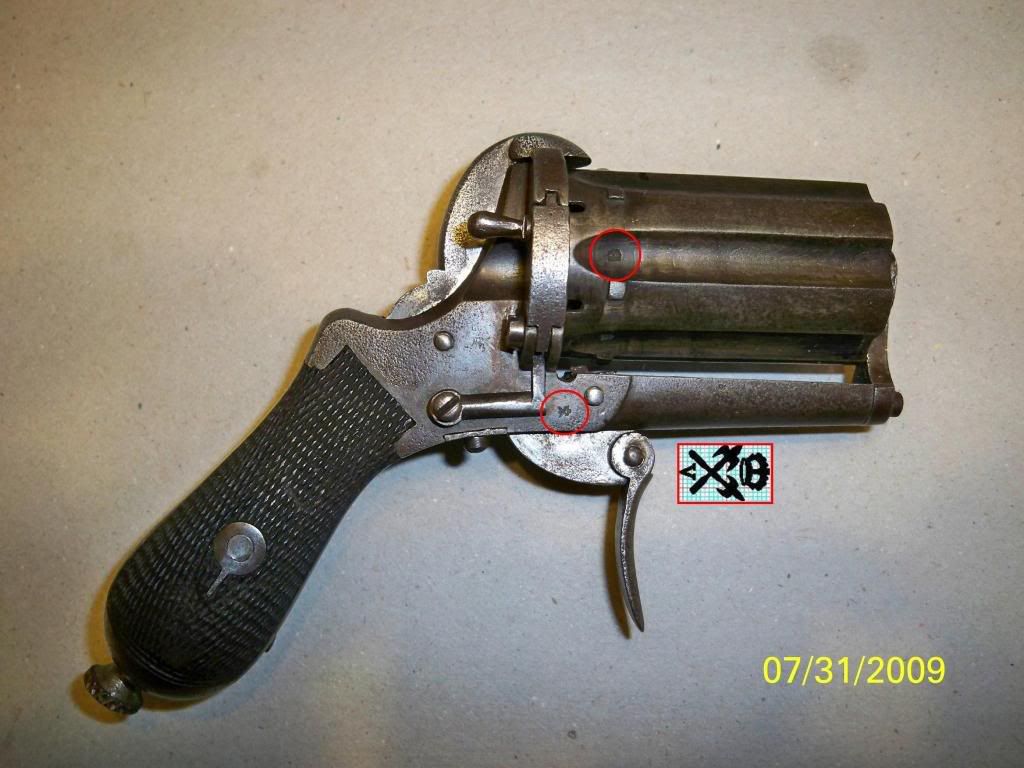
No Belgium Mark ( Punches of test or Control) 
Markings ]Crown and Letters "DAF" or "DAE" not sure. 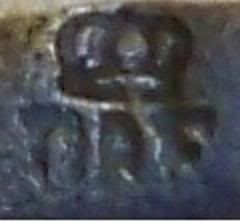
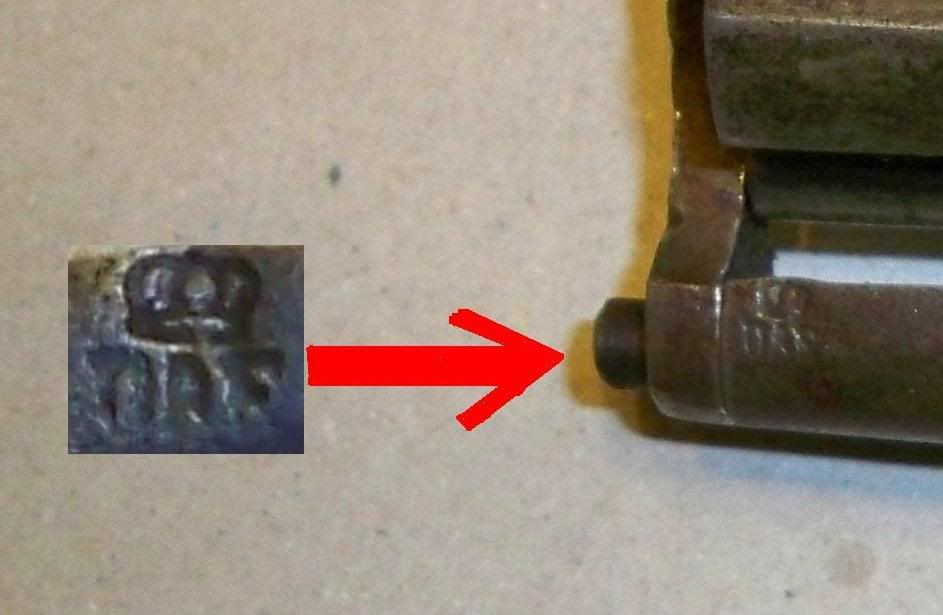
Right Hand Side Grip 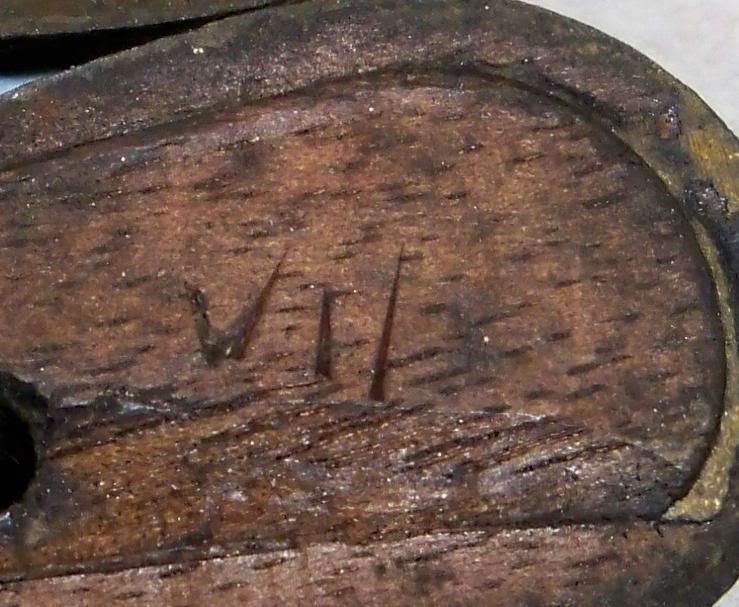
Left Hand Side Grip 
Right Hand Side of Lower Frame Note the "L" 
Left Hand Side of Lower Frame Note the "GD" 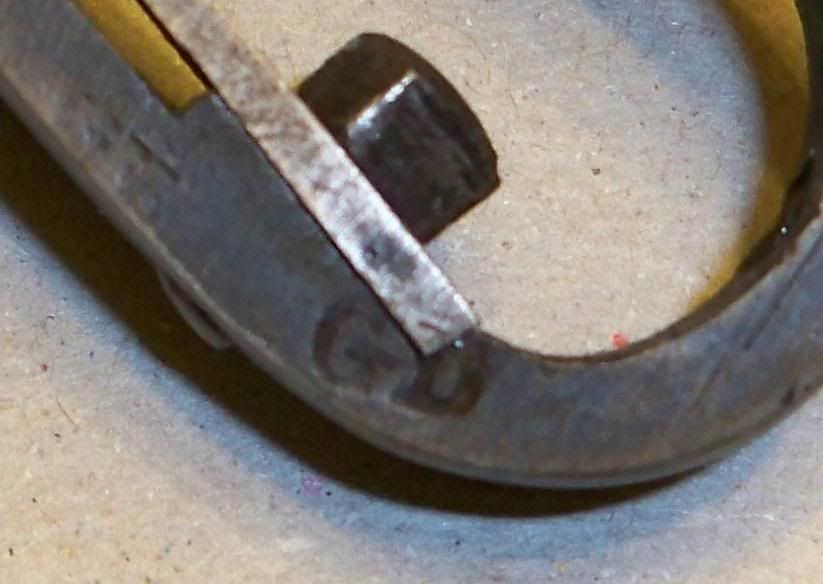
Front of Fluted 6-Shot Cylinder Either a "JS" or "IS" or "1S" ETA While on Photobucket I noticed something. It looks like another letter or number that is also partially worn out near the hole. 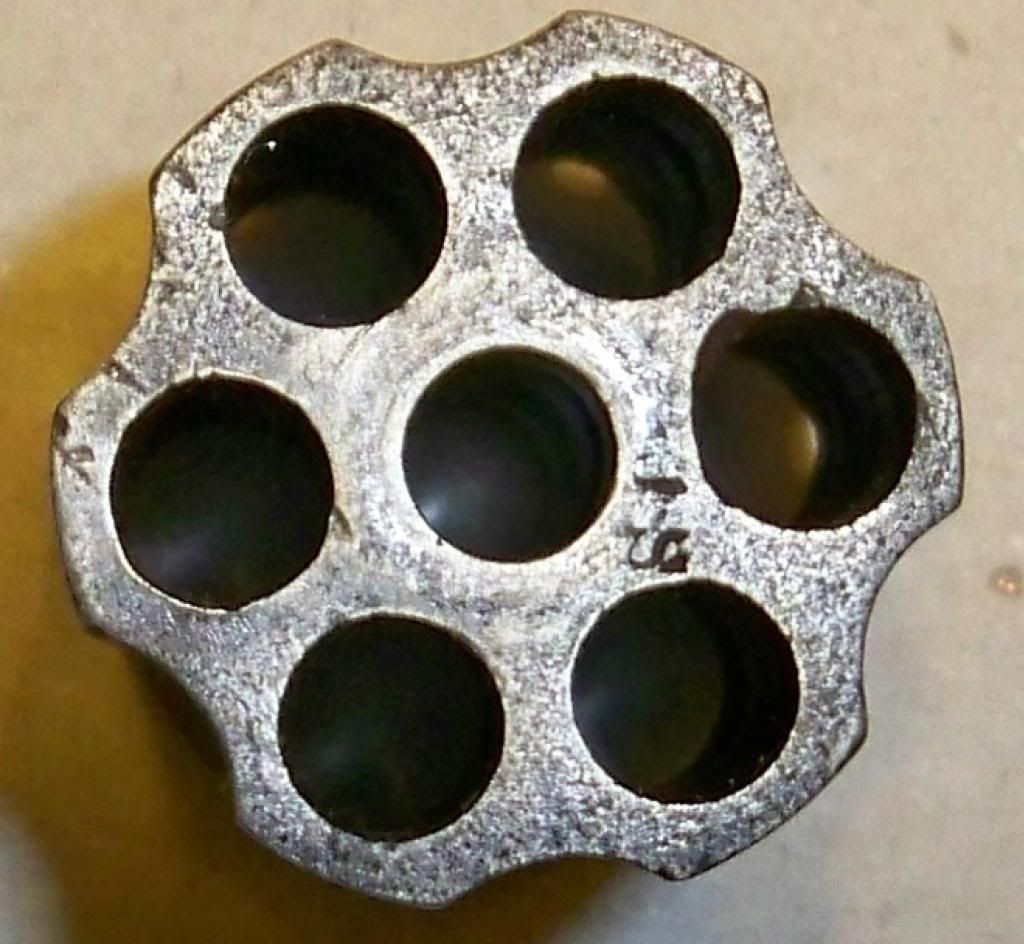
Back of Fluted 6-Shot Cylinder Four notches and what looks to be "II" or "11". 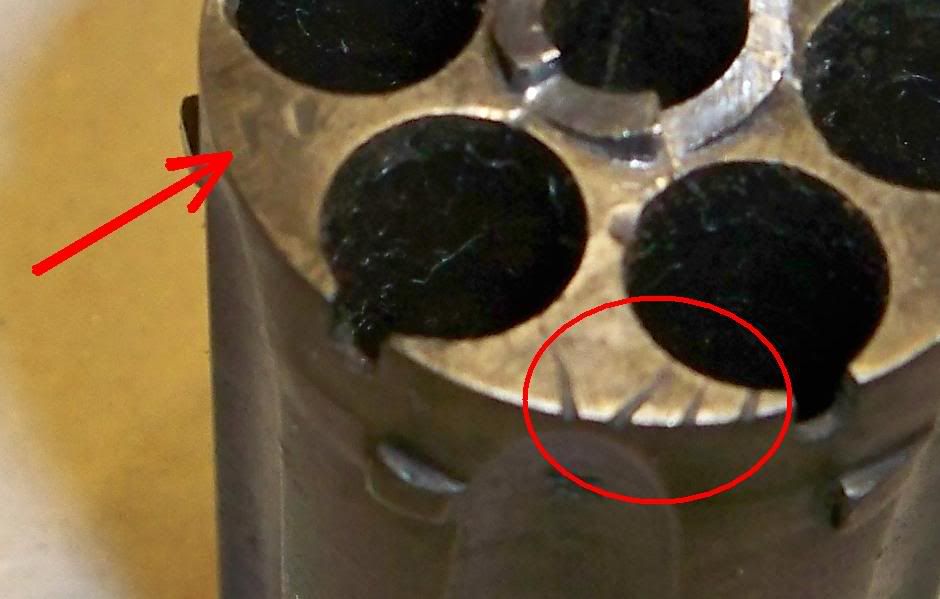
Front of Frame 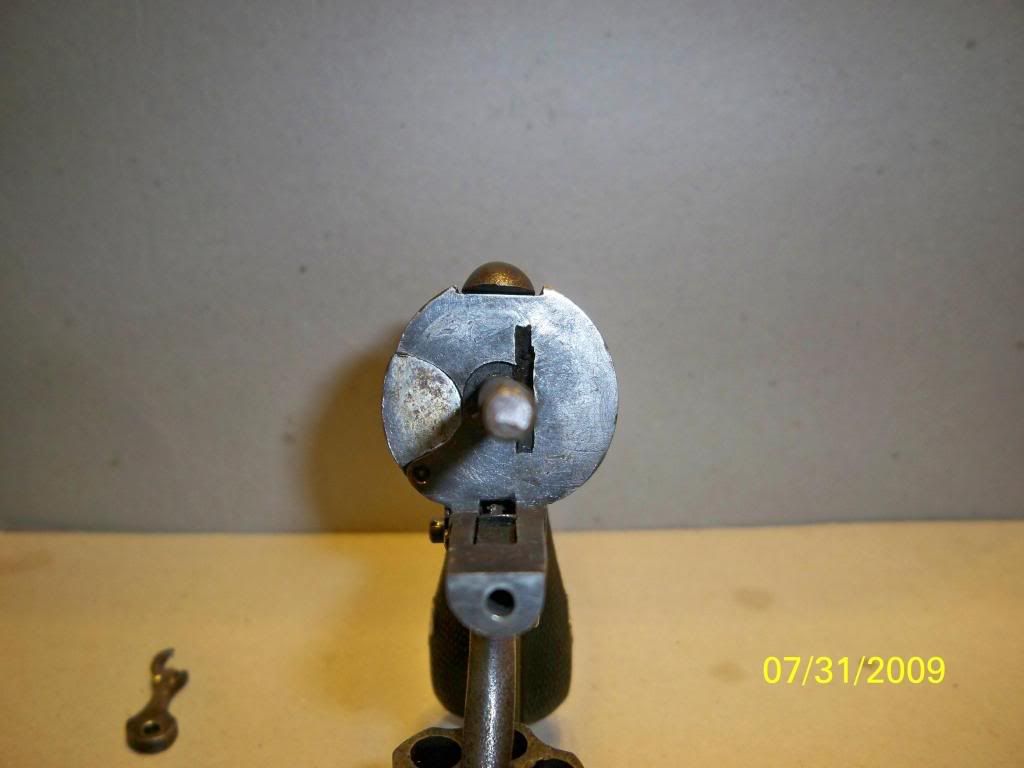
Basic tear down Note that the front Cylinder Mount was damaged by some previous owner Also the Large Fancy Watch Screw is suppose to be about two inches longer to be used as an Extractor Pin 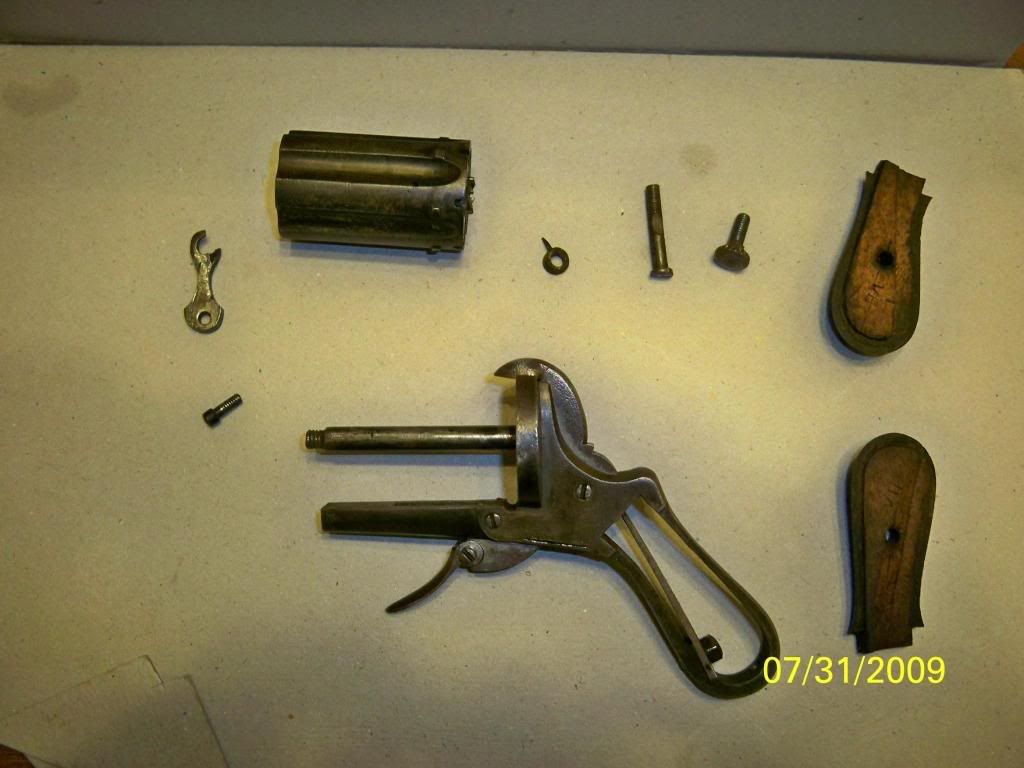
What the Extractor Pin should look like. 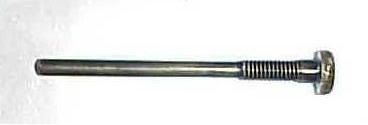
|
|
|
|
cool
what year and what manufacturer, do you know? edit- oops read you don't -french belgium maybe FN. may be 1870's era-my best guess what were you using for close up photos? |
|
|
|
Some information on Proofmarks..
From www.littlegun.be/ This one caused alot of problems. Most countries proof their firearms. When the arm passes the test a proofmark is punched on vital parts (Duits: Beschußzeichen, French: Poinçon). On this page you'll see some Belgian proofmarks. The Belgian proofing institute is situated in Luik (Banc d'épreuve des armes à feu). Due to a fire in 1922 all the archives of inspectors were lost resulting in the fact that punches applied before 1922 can't be traced back to the applying inspector or the date the arm was punched. More proofmarks: http://www.proefbankstempels.nl/
No Belgiun mark (Punches test or control) 
Proofmark (normal testload) 
Proofmark (extra load) 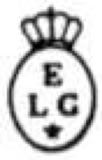
Proofmark (Poudre Vive; smokeless) 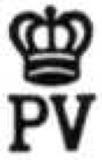
Proofmark smokeless powder (excessive pressure 50%) 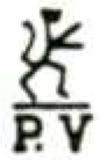
Proofmarks for black powder. "R" stands for Rifled barrel (Rayé) 
Belgian Proofmark for foreign arms 
Voluntary proofed 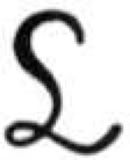
Proofmark (A..Z) from 30-12-1853 till 26-01-1877 
Proofmark from 27-01-1877 till 26-02-1968 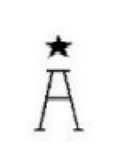
ETA Fix Desciption of No Belgian |
|
|
|
Found a look alike using www.ixquick.com
Its suppose to be a Lefaucheux made or copied Pinfired Pepperbox. 8mm Pinfire Pepperbox, Late 19th century The pepperbox experienced a kind of "revival" in the late 1800s as a short, easily concealable pocketweapon that used pinfire cartridges. A special variation of this kind of handgun, in which the shortness of the barrel cluster was fully utilized, is the French "Apache revolver." This weapon, allegedly popular among Paris street gangs, was fitted with a folding blade and knuckle-duster.[11] The pepperboxes from this period disappeared with the demise of the pinfire cartridge.
http://en.wikipedia.org/wiki/Pepper-box 
It has some visible damage to the cylinder (Drilled Holes) with missing hardware like the front barrel mount, extractor screw, and trigger screw. Also has a different hammer. Looks like it may have been changed. I read on one site that since these were pocket guns it a replacement hammer or ordered that way in the late 1800. It also has a cheaper look to it almost stripped down. This revolver to me looks like it may actually be Pre 1860 rather than late 1800. The hammer is whats throwing it off. Looks like the serial number is 870 or 1870 on the grip which can also be the year of manufacture. If it were 1870 it would have real markings with S/N stamped in the steel on both sides. Its very unsual to find the markings on the outside of the grips. Since there is no pictures of the reverse side one cant tell. Some S/N were later added for recording the transaction of gun sales but never on the wood. The only guns that I found with S/N on grips for used buy police departments. But a Pepperbox? Maybe. Its suppose to be a 8mm Pinfire. That makes it more rare. I would really like to see the markings. ETA Cleaned up the WIKI info. Refered to to many guns. Included what I noticed about the revolver and posibility of age. |
|
|
|
I found this dealer here in the US.
http://www.cwslagleantiques.com/view_detail.cfm?catid=66&id=2612 Unique Pipe Cased and Monogrammed Belgian Pinfire Pepperbox Revolver:
Serial no. 3, 7mm caliber pin fire, 2-inch barrel, blue finish ebony grips. There is a pre 1893 Liege proof mark on the rear face of the cylinder along with a crowned “F” proof, the serial number, and three notches. The right side of the frame under the grip has a “TL” maker's mark. The cylinder is 2 inches in length and holds six cartridges. Folding trigger, smooth ebony grips. The ejector rod screws in to the butt. Complete in a black morocco leather case with a blue stain and velvet French cut interior with four rounds of original 7mm pin fire cartridges. The exterior of the lid is stamped with a white crown over a gold script “Y H” and two gold borders. Condition: Very good plus. Two of the cylinder flutes have most of the original blue finish with the remaining metal surfaces a silver/gray patina. The cylinder, trigger and hammer have scattered light to moderate pitting and there is a small area of minor pitting on the top right of the frame. The grips are good with a few scattered minor scratches. Mechanically fine. The case is fine with some minor corner and edge wear. Over half of the gold leaf border remains with most in the letter “H” and most gone in the letter “Y.” the interior is good with some wear, rust on the hinges and overall moderate stains. PRICE: $1,500.00 Request More Information Purchase Item 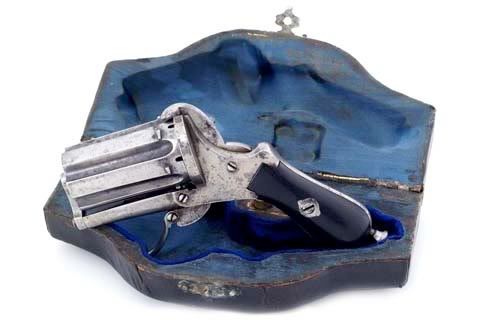
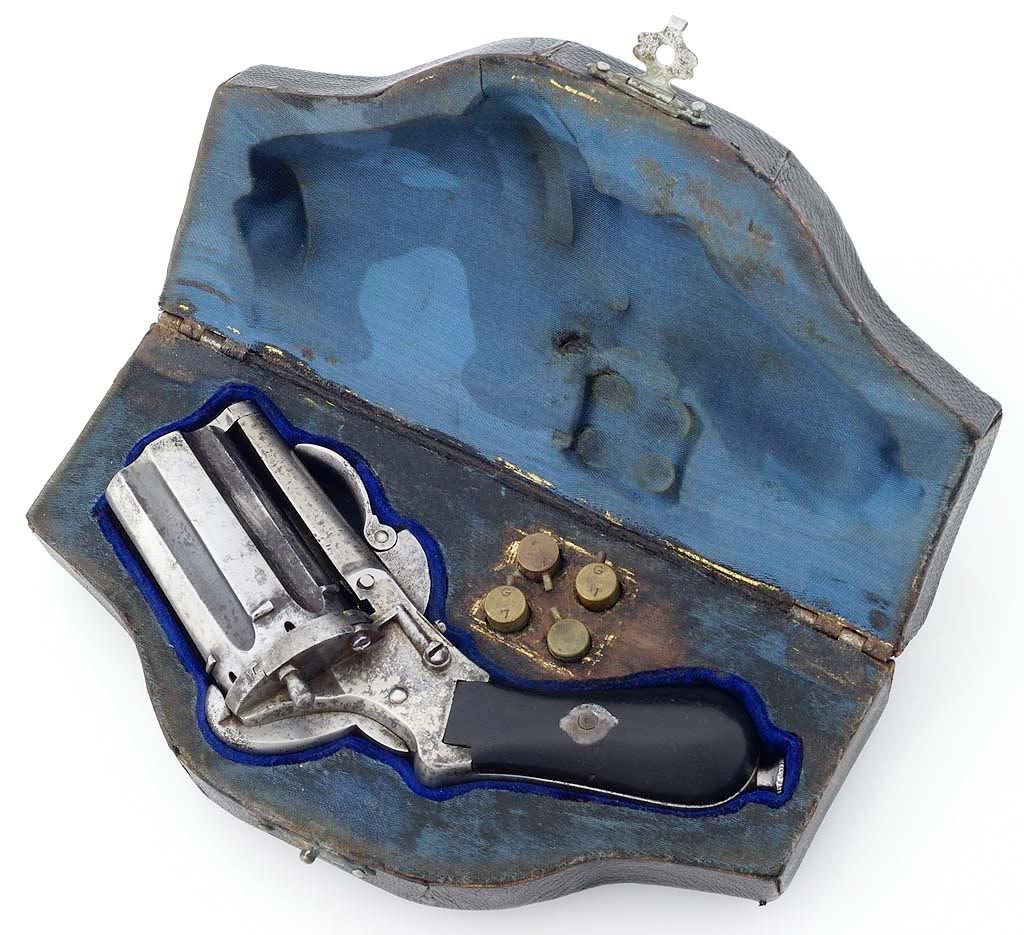
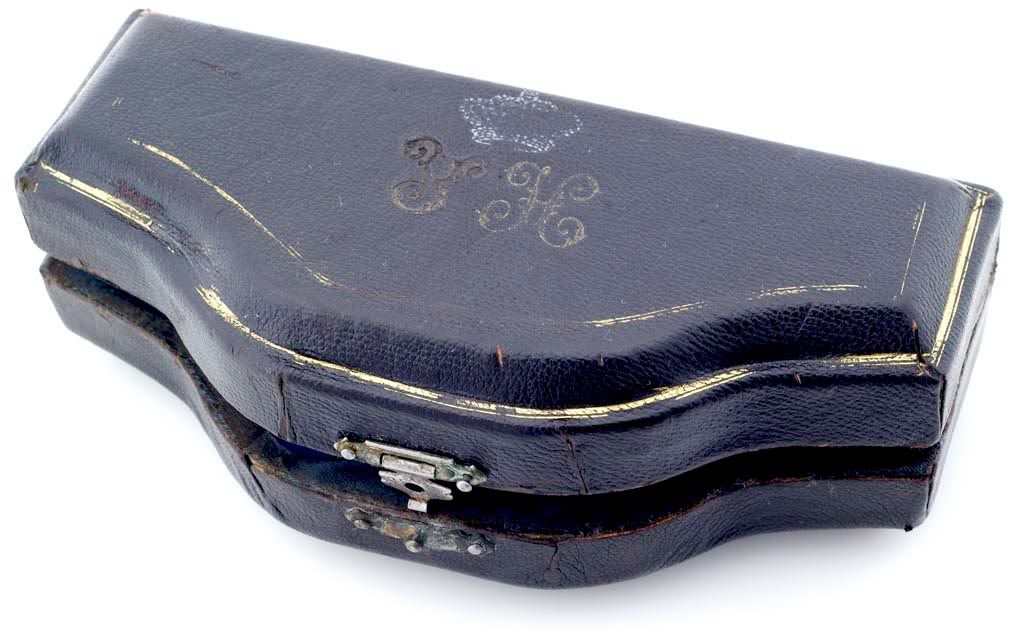


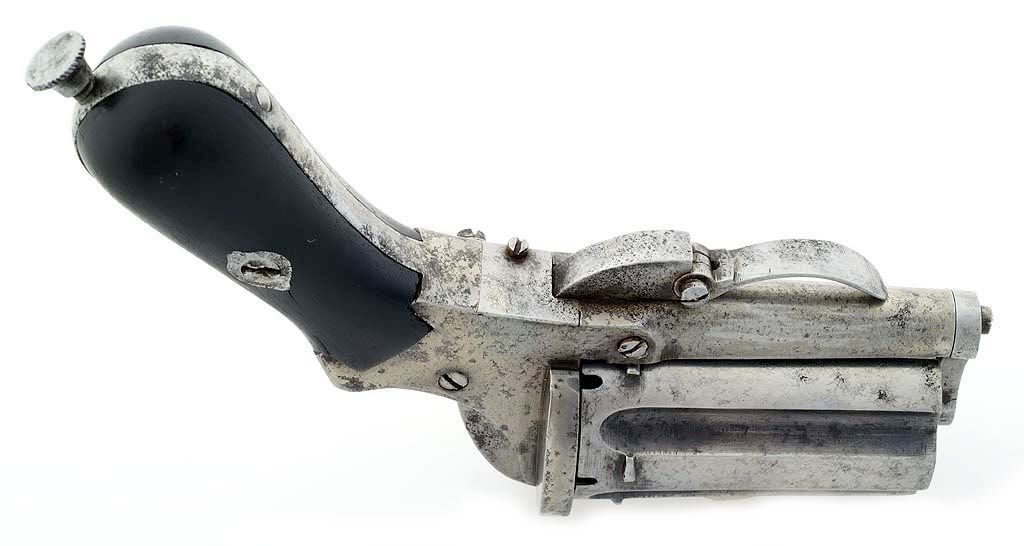
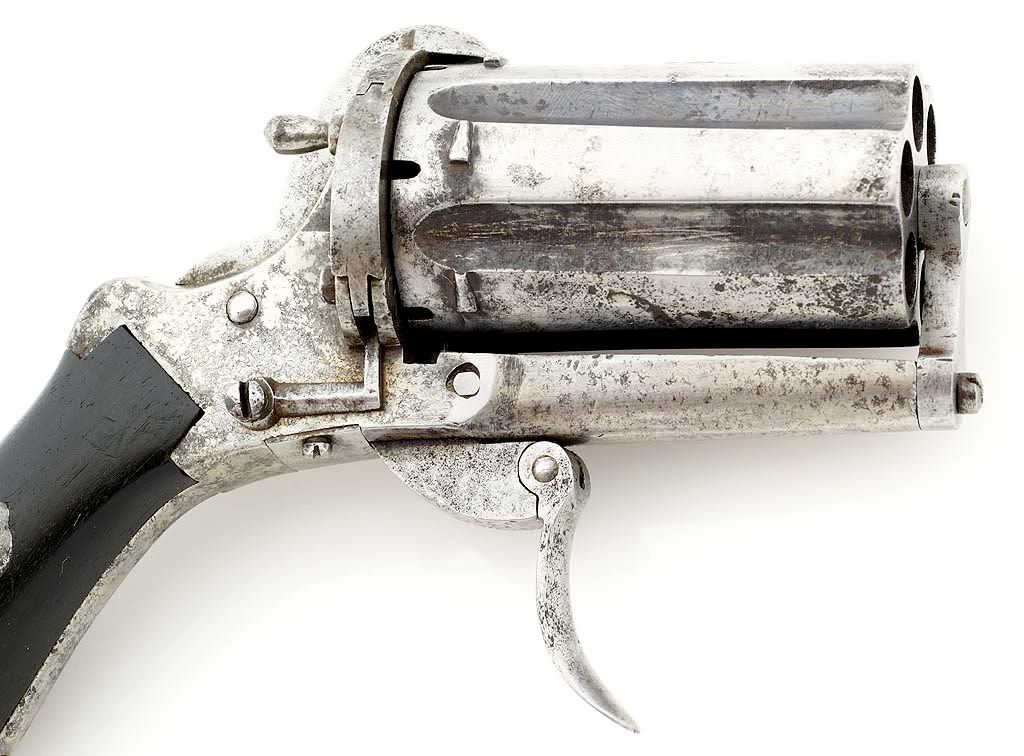
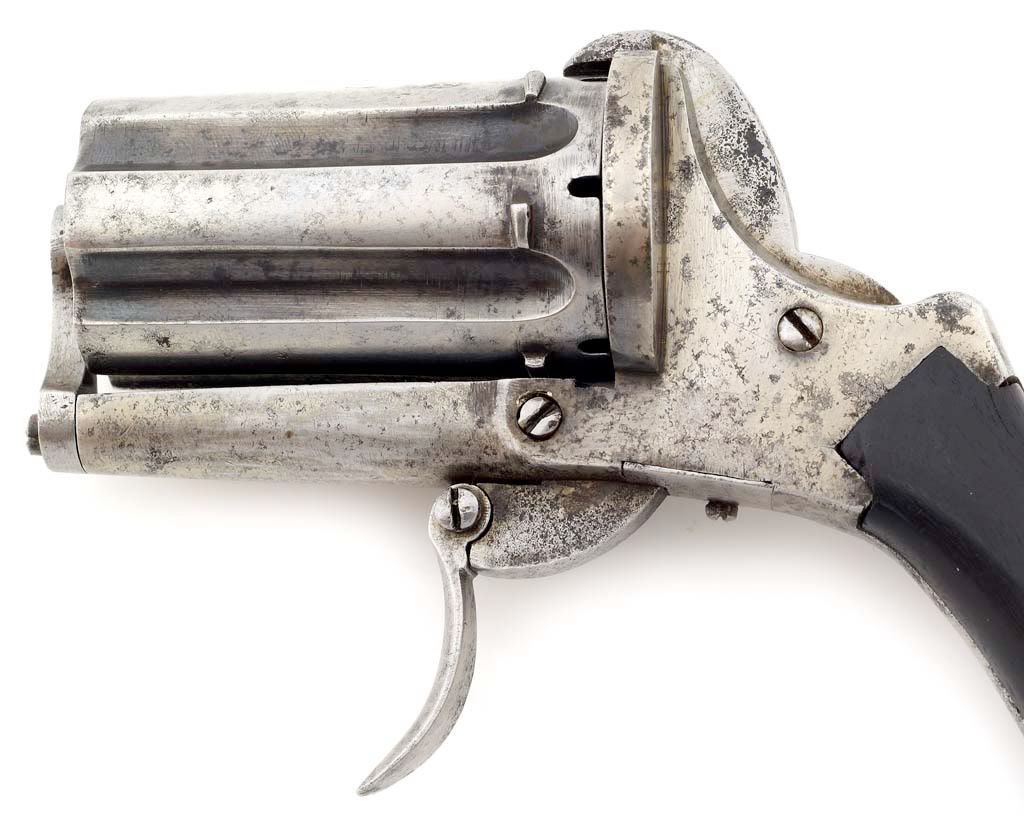
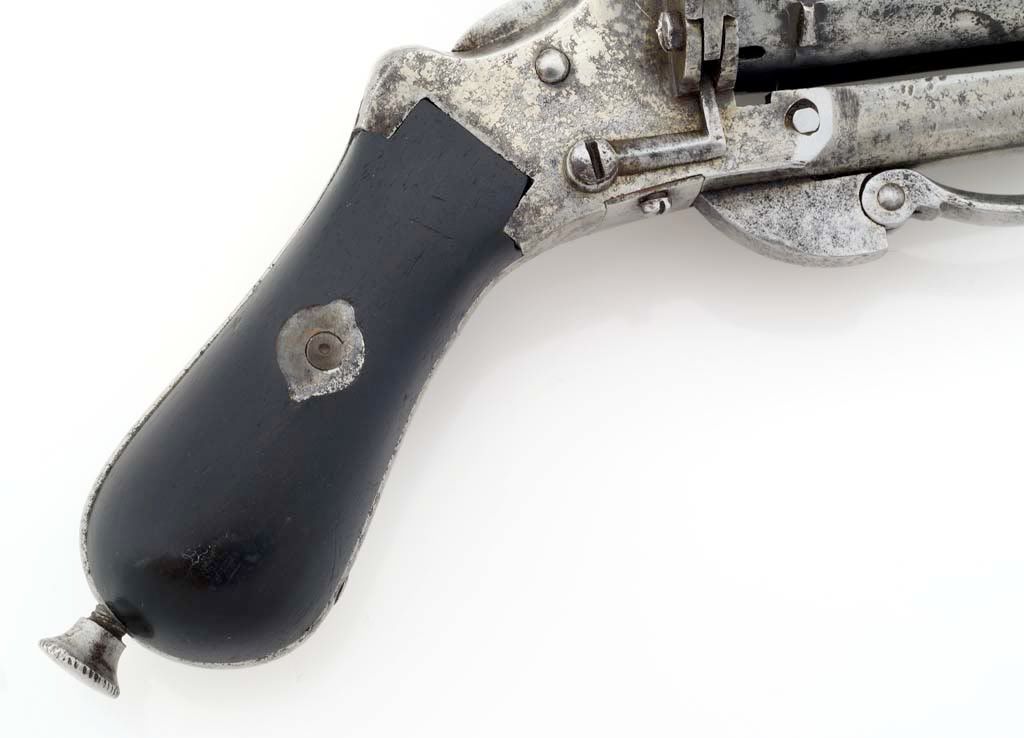
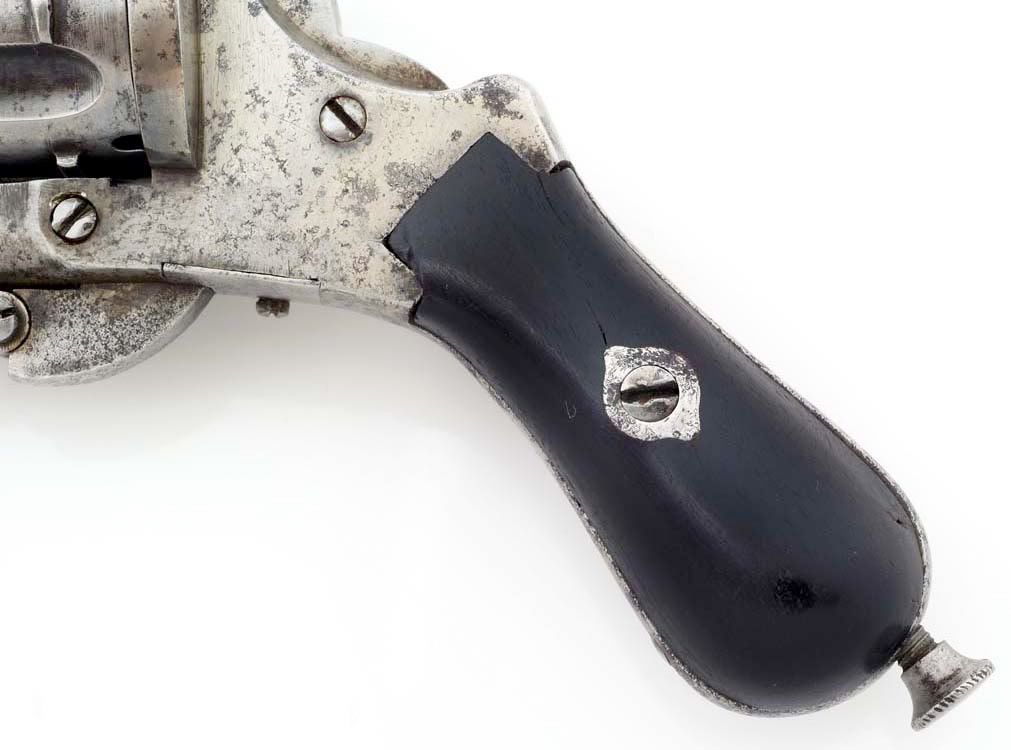


I would love to see this Pepperbox without the grips off, and the cylinder ends. It does not seem to have open markings. The underside of the box should have a label with manufacturer, model #, engraver, date and S/N. |
|
|
|
|
|
I'll see if I can find it. I saw one the other day that looked like mine with a barrel added to the front. It was nickeled of course..
Sorry I didnt answer right away. I was researching. |
|
|
|
I have one that looks a lot like it, it's a Meyers Brevette. Pepperboxes are sweet.
|
|
|
|
|
|
I wish, that would be cool. It looks like yours:
Similar to this one without the engraving http://home-and-garden.webshots.com/photo/2895187180099764168rwsQaQ |
|
|
|
|
|
Quoted:
Meyers Brevete http://www.littlegun.be/arme%20belge/artisans%20identifies%20m%20o/meyers%20magazin%20royal-02.JPG I'm going to have to look up what Brevete means. Just check that in business it means patented or patent protector.. Ah, thanks, that explains it. |
|
|
|
WOW!! No front cylinder mount. Front of the frame rounded. I hope that the hole in the cylinder bolt isnt being used for a laynard. 
Good thing that these guns are made for short range. I had found a link last week to a test firing of a 7mm Pinfired pepper box. They showed the bullet stuck sideways in a sheet of plywood. It was only about twenty feet away and the bullet tumbled sideways. I guess that length of the barrel does make a big difference. ETA Fixed it for you.. Had to post it |
|
|
|
Quoted:
Quoted:
I wish, that would be cool. It looks like yours: Similar to this one without the engraving http://home-and-garden.webshots.com/photo/2895187180099764168rwsQaQ WOW!! No front cylinder mount. Front of the frame rounded. I hope that the hole in the cylinder bolt isnt being used for a laynard. 
Good thing that these guns are made for short range. I had found a link last week to a test firing of a 7mm Pinfired pepper box. They showed the bullet stuck sideways in a sheet of plywood. It was only about twenty feet away and the bullet tumbled sideways. I guess that length of the barrel does make a big difference. I think they are unrifled right? Mine is buried in the safe and I'm too lazy to check. They are cool boogers, especially when you think about how they are ~150 years old. |
|
|
|
I just found this video.
http://www.youtube.com/watch?v=GNgQJGkEWAU Real pistol and fired at what looks to be plywood. It impacted going backwards. At least it went through it.. Backwards. 
BTW Planning to get this ammo kit to try out the pepperbox after I get back on my feet(physically]. Just need to find out how much powder will be needed. Its a set for a 5 round kit for only $36 with free shipping less #11 percussion caps because of import regulations. Larger sets are available.. 
http://hlebooks.com/pinfire/prices.htm#7mm%20PINFIRE |
|
|
|
Just ordered the 5 pc starter set($36 with free shipping). I could not order the 12 pc set ($46)and 25 bullets($16) plus shipping.
The links were not there or working. I could have saved money buying the larger set. |
|
|
|
The older ones are not rifled unless the buyer ordered them that way then they were probably nickleded,bronzed, gilded gold, silver, gold, and have fancy or ivory grips. Ost 1870 most of them were made rifled.
Read an blurb that some manfacture today are making replicas. Cheaper to buy the antiques.. |
|
|
|
Just ordered this book from AbeBookss.com
It includes 312 pages of 312 pages covering the civil war the Lefaucheux Pinfired system and photographs 52 markings 70 Inspection proof markings Systems Lefaucheux: A History of Pinfire Arms & Their Role in the American Civil War 
ISBN 10: 1882824199 / 1-882824-19-9 ISBN 13: 9781882824199 Publisher: Graphic Pub Publication Date: 2002 Binding: Hardcover $44.95 plus $4 shipping http://www.abebooks.com/products/isbn/9781882824199/Chris+C.+Curtis/Systems+Lefaucheux:+A+History+of+Pinfire+Arms+&+Their+Role+in+the+American+Civil+War/ $44.95 plus $4 shipping Amazon was $105.87 plus shipping ETA Ishould check the links before posting.. 
My luck is that this book will go on sale for $10 somewhere. Maybe the next yardsale that I check out. ETA Could have bought it at Track of the Wolf for $39.95 plus shipping http://www.trackofthewolf.com/(S(5ll3xz554yanou2zsc3cni55))/categories/partDetail.aspx?catId=4&subId=24&styleId=71&partNum=BOOK-SL |
|
|
|
Found that page with the No Belgian mark..
I also noticed that the cylinder on the Degueldre pistol had the No Belgian mark on all chambers as mine has on the flutes of the pepperbox. This was a major clue that flew over my head the first time that I read it. Should have read it more the first time. http://www.littlegun.be/arme%20belge/artisans%20identifies%20d/a%20degueldre%20gb.htm Degueldre 7mm pinfire.
If it is not single (?), this model is excessively rare in this caliber. Indeed, we know 2 weapons in this form which I described as "prototypes" in the article published in the review "the Museum of Weapons" n° 107-108 of December 2004. Both in 12 mm with pin. That of the Museum is of nickelled completion and that of my collection is bronzed black. To "artisan" manufacture, one belongs in addition to the length different from the guns, a trigger guard broader and located ahead on the specimen of the Museum of Weapon of Liege, a squaring different from the grips; the gun is striped and a light squaring on the tail of the hammer on the specimen of the author and non-existent on the other whose gun is smooth. No Belgian marking (punches of test or control) is reproduced on these 3 weapons.
The presence on the 7 mm of punches of English test (Birmingham) does not make it possible to cancel a Liège manufacture because, indeed, except error of my share, all the imported weapons were tested once again in England. The manufacturer: of his collaboration with LEDENT François Joseph, manufacturer of Saint-Remy weapons, with whom it deposit, between 1864 and 1870, 6 patents or improvement, one can suppose that it is Ledent which assembled Degueldre "of the 1st type". It should be known that at that time in Liege (about 1860-1880), NO firm manufactured a weapon in its totality, the "manufacturers" (* 174 listed in 1884) were actually assemblers which ordered with the many craftsmen available (* 11.204 people listed in 1880 in the sector of the firearms other than the women and of the children, casual workers), the various parts necessary (carcass, gun, barrel, stem of extraction, trigger, plates...) for such or such type of weapons and these parts were often made "at home" by families specialized in the production of only one component. The inventors conceded readily with one or more manufacturers, in exchange of "royalties" the manufacture of the weapon resulting from their imagination, in the same way, if the orders were important, the manufacturers sub-contracted a share of their production or constituted themselves in "trade union" to face the request (thus was born the F.N.). But let us return to this revolver in 7 mm to pin which presents the three innovations that one can allot to Degueldre: a system of lever allowing the projection of the block barrel-cylinder, a collective extractor made up of a steel circle surrounding the barrel, with the limit of the notches necessary to the exit of the pins, fixed at the shield and the small lever at spring, installed in this shield, which is erased under the pressure exerted by the introduction of a cartridge and is positioned back on the base, very preventing left inopportune. There be no BELGIAN patent (1) concerning these innovation and yet one find on the version "simplify" of Degueldre (see photo more low in this heading) which have be marketing and A seem it known a success relative, the marking "Degueldre patent" (2). The principal differences are as follows: The lever which is used to advance the cylinder-barrel unit is decentred and simplified and is located on the right side of the weapon, it fixes itself at before right of the barrel, but the functionality remains identical. The handle is round, in the pear shape, and narrower with also a ring of cap. The barrel, with eight sides, at the base, becomes circular starting from the quarter its length (145 mm), which was increased of almost 20 mm. On these weapons are reproduced the punch test of Liege - ELG on star in an oval and usual punches of control - crowned Letter. One also notes on the illustrated weapon the presence of marks of British test at various places. Logo EL crowned being reproduced on the left side of the gun is perhaps that of Emile Lepage, manufacturer of weapons in Liege of 1850 to 1872 Hausoul Ph (HPH)
(1) Whereas Constant-Joseph Degueldre is patentee three deposited in Belgium, on a purely individual basis. (2) If a reader of this article were informed of a patent deposited in the name of Degueldre concerning this type of weapon in another country (England, France, Switzerland...), I would be grateful to him of me to make share of it. * according to C GAIER, Cinq Siècles d’Armurerie Liégeoises – Editions du Perron 1996 |
|
|
|
NH_AR_Shooter and I got togother on Sunday to photograph the pepperbox with his digital camera that has a better macro capabilities than my camera.
While taking pictures he started noticing more sets of 4 notches on other parts on his display.. Wow I missed alot. 
Unless I take the Hammer/trigger assy apart(That would be a bad ideas) I cant tell what else is in there. So far we have found 4 notches on the following: Cartridge gate Back of cylinder front cylinder mount Front cylinder mounting screw Frame under hammer spring Grip screw Grip nut for RHS Grip Folding Trigger Trigger lower( where folding triger attaches) top of Detent two on right 2 on left side Left and Right grips marked VII or four notches Posible odd letters on rights side od Hammer. |
|
|
|
Just to pass this on to anyone else who may have a severely rusted firearm. My father was given two pistols that were so rusted the actions would not budge. The shop said they were in house fires and then allowed to sit. The pistols were scaled with rust and when I first seen them I thought there was no hope of cleaning them up.
The method I used was electrolytic rust removal. Here are a few guides: Electrolytic rust removal PDF Another short guide A video After using the same method we were able to read what make and model the pistols were. The actions worked other than the springs that were ruined in the fire. I used a 6 amp charger overnight with the solution. I used washing soda rather than backing soda as mentioned in the video. Also, don't do this inside as it gives off hydrogen gas which is explosive. Just a tip that might help others out Dolomite |
|
|
|
Quoted:
Just to pass this on to anyone else who may have a severely rusted firearm. My father was given two pistols that were so rusted the actions would not budge. The shop said they were in house fires and then allowed to sit. The pistols were scaled with rust and when I first seen them I thought there was no hope of cleaning them up. The method I used was electrolytic rust removal. Here are a few guides: Electrolytic rust removal PDF Another short guide A video After using the same method we were able to read what make and model the pistols were. The actions worked other than the springs that were ruined in the fire. I used a 6 amp charger overnight with the solution. I used washing soda rather than backing soda as mentioned in the video. Also, don't do this inside as it gives off hydrogen gas which is explosive. Just a tip that might help others out Dolomite Thanks for the info.. I found the simular info. on the Littlegun website, but. This will help you. Restoration Page http://www.littlegun.be/arme%20belge/restauration/a%20a%20restauration%20intro%20gb.htm It also includes a page on how to make a restore springs... |
|
|
|
Found out that this Symbol is also known as the Birmingham Gun Makers view mark 1813-1904.

Looks like my little gun may have stopped and was tested in England. Not sure.. Need more info.... British Rules http://www.dave-cushman.net/shot/proofmarks.html Gun Barrel Proof Marks
Markings on gun barrels and other gun components that indicate the level of pressure, calibre and standards that a weapon is fit for in service. The drawings vary in style due to differences in the original information. Most are black silhouettes, but some of those that have been produced from photographs have a quasi 3 dimensional appearance that requires the onlooker to imagine that the light source is in the top left hand corner of the screen. De bossed or panelled marks show the depression in grey, with the original metal surface shown white (or transparent if shown against a grid). The proof certificate is in Spanish, but the dimensions and tolerances are recognisable. Where possible the drawings will be presented against a gridded background as shown at right. The red squares in the grid represent two millimetres, but the images themselves may not be to an exact scale, mainly because the depth to which the marks are punched and the angle at which the punch was held when it was struck will also affect the size and shape of the mark. I have tried to be consistent in the application of this grid as a background to the individual marks, so that sensible comparisons may be made. However in measuring a large number of marks, I have found variations as large a 20% in some cases, although the majority will fall within plus or minus 4% of the drawings. There is a further complication in that punches of different sizes are used according to the size of weapon and so you may have marks that do not agree with the measurements as displayed here. In cases where I cannot be certain of relative sizings the grid will be omitted. The symbols have been gathered from a large number of sources including magazine and book illustrations, the drawings themselves are all my own work. In some cases the pressure reached during proof is given rather than the service pressure for which the weapon is intended. It does not mean that a weapon can withstand such pressures repeatedly. Reasons for Gun Barrel Proof
Gun Barrel Proof, or proof testing of firearms and the ammunition that is used in them is compulsory in the UK. It was brought about by reputable gun makers in order to establish the safety and integrity of the firearms concerned, thus giving protection to the user and establishing a quality standard. British Proof Law as represented by the Gun Barrel Proof Acts of 1868, 1950 and 1978. The "Rules of Proof" are defined under the authority of these Acts. The "Rules of Proof 1954 & 1978" can be purchased from either of the London or Birmingham Proof Houses. The 1954 rules, which were originally approved by the then Ministry of Supply, came into effect on 1st February 1955 and xx dd ???? for the 1978 act, however Proof under the earlier Rules of 1875, 1887, 1896, 1904, 1916 and 1925 remains valid provided the weapon still conforms with the Proof Marks of the time in terms of dimensions of the bore, load, nature of propellant, and has not been materially altered in any vital aspect including such as chamber length, re-sleeving, chromium plating or any other form of metal deposition in the bore. The "Rules of Proof" derive their authority from the Proof Act. They apply to all Small Arms, within certain limits of bore size and projectile weight, but do not include weapons made for the use of HM Forces. Proof Testing of these military weapons falls under the jurisdiction of the Directorate of Inspection of Arms who use their own Proof Marks. The "Rules of Proof" do not apply to air weapons or other guns that do not use an explosive propellant cartridge. Types of Proof fall into three divisions:- (a) Provisional Proof. (b) Definitive Proof. (c) Special Definitive Proof. Provisional Proof... This is mainly for the convenience of the gun trade. It is applied only to shot gun barrels and is intended to weed out non obvious faults and prevent the maker from wasting time and effort on a tube that is faulty. The gunmaker submits his tubes to the Proof House which deals with them in a manner described on the Proof Methods page. If they are satisfactory they are returned for the work to be continued. Definitive Proof... All weapons must undergo this, either in the "white" or when fully finished. Special Definitive Proof... This applies to weapons that are intended to be used with loads that develop pressures greater than the normal service loads expected with this type of weapon. This can be done either as the compulsory proof of a weapon that is deliberately designed for heavier than usual loads or as a result of a person wishing to use a heavier load in a weapon that was not originally proved to that standard. Re-Proof is required after a gun has been proofed and used, but a change in condition or dimension may cause re-proof to be required. The most common causes of this are:- •Increase in bore size or chamber length that causes the original proof to be invalidated. •Enlargement of bore diameter in removal of pitting weakens barrels and is the most common cause of barrels becoming out of proof. •Physical signs of failure or possible failure such as pitting of the barrel, cracking or bulging. •Replacement of the barrel, re-sleeving, welding brazing or electrolytic deposition of any form including chromium or Nickel plating. •Fitting a device such as a muzzle brake, if a rifle or a variable choke if a shot gun. •Use of a propellant or load which produces a pressure in excess of that for which the firearm was designed. Particularly to the use of smokeless cartridges in a gun designed and proofed for black powder only. Regulations relating to Gun Barrel Proof
Proof may be defined as the compulsory testing of every new firearm before sale. The purpose of the testing is to ensure that the purchaser and/or user of any shot gun, sporting rifle, pistol or any other weapon which uses a propellant cartridge, can do so with the clear knowledge that his/her firearm is safe to use with the defined "normal" load. The word "compulsory" is used and this compulsion (in the UK) is provided by an Act of Parliament... In 1637 the Gunmakers of the City of London, usually known as the "Gunmakers Company of London", was granted a Royal Charter to protect the public against unsafe weapons being made and sold, the Company secured Ordinances in 1690 which enabled it to enforce "Proof" among its members in the London area. The other main manufacturing region was the area was around Birmingham and in 1813, at it's own expense, the Birmingham Gun Trade introduced a Parliamentary Bill setting up a Proof House to be operated by the "Guardians of the Birmingham Proof House ". Therefore, since 1813 at least, it has been a punishable offence both to sell or offer for sale (including auction) any unproved weapon in the United Kingdom. It is also an offence to export such a weapon or to pawn one. Penalties for such offences are imposed on a per barrel basis. Forging or altering a proof mark is considered a greater offence and carries heavier penalties. The Firearms Act of 1868 (Section 122(4)) makes it an offence to import any small arm into the United Kingdom, unless it carries foreign proof marks that are accepted under reciprocal agreement, unless their arrival is notified to the Proof Master at London and Birmingham within seven days and/or they are submitted for Proof within 28 days. This ruling apparently does not apply to anyone who imports an unproved arm for his/her own personal use. While it remains his/her personal property it can be used unproofed. Whilst it may be legal to use such a weapon it would be foolhardy to use this loophole to avoid proof. For you own peace of mind... submit the weapon for British proof. other rules Reciprocal arrangements have been made by various countries:- •Austria Austrian proof marks were accepted in the UK pre WW II, but only marks post January 1956, are now valid. •Belgium... The specifically recognised marks of the Proof House at Liege only. •Czechoslovakia... Marks of the Czech Proof Authorities have been recognised in Great Britain since 14th October 1963. •France... Proof was optional in France prior to July 1960. Only specific, agreed, marks applied after that date are valid in the UK. •Federal Republic of Germany... new marks from September 1955 are acceptable, but marks prior to that date are not now accepted. •Italy... The current marks are accepted. •Ireland... Irish proof is acceptable after 9th June 1969. •Spain... Spanish proof is accepted. The products of all other countries, including the United States of America, must be submitted for proof within 28 days of importation. The marks of these foreign countries are only valid if the marks are the current version. Proof Marks on a foreign weapon should be compared with the illustrations in the "Notes on the Proof of Shot Guns and Other Small Arms" if you wish to be certain that a particular weapon is still "in proof". Submission for Proof or Re-Proof... Anyone may send a weapon for proof at a Proof House, but this is not a good idea. Before the gun can be subjected to proof the action must be in good order and tight on the face and, if applicable, the head space must be correct because the proof process involves subjecting the gun to a greater pressure than that produced by the normal load. The barrels must be "struck up" with the bores smooth, pitting removed, bulges knocked down and dents raised. Undoubtedly the best procedure is to have a gunmaker carry out the preliminary work and then when he/she is convinced it is in adequate condition, for them to submit the weapon to the Proof House on behalf of the owner. The Proof Master has the right to refuse any firearm for proof which cannot be viewed adequately to reveal defects or be safely loaded and fired with a Proof Load. There are four classes of Small Arms Proof:- First Class... Smooth bore breech loading guns of 4 bore or smaller. Second Class... Rifled breech loading weapons discharging shot or bullet. Third Class... Pistols with barrel length less than 14 inches, but otherwise as Second Class. Fourth Class... All other firearms and all other devices that use black powder or other propellant, as well as any items declared to be "arms" by the Proof Master or by the person requesting proof. Testing Methods Used in the Proof of Firearms
Viewing... When a firearm is submitted for Proof the first stage of the procedure is known as "viewing". A weapon which does not satisfy the Proof House viewers is ruled not to be in a fit condition for rest of the Proof process. The viewing procedure is as follows:- •The weapon is classified, i.e., it is allocated to one of the four classes. •It is visually inspected for defects and the straightness of the barrel(s) is checked. •Weapons of the first class and long barrelled weapons of the 4th class are bore gauged at 9 inches from the breech face and the bore diameter is taken as that corresponding to the largest gauge which will enter to that point. If the diameter does not lie within prescribed limits the arm is rejected. •Measurements are taken of chamber dimensions, as given in the diagram below:- each of which must lie within prescribed limits. The dimensions quoted in the "Rules of Proof" are for finished chambers. To allow for polishing after Proof the minimum figures of dimensions A, B or C are read as if they were 0.003" less. •Weapons of the 2nd and 3rd classes are also gauged. The length of the chamber, each diameter of the chamber(s) of the barrel(s) and in a revolver each chamber of the cylinder must lie within the prescribed limits. •Weapons of 4th class present a number of problems due to the wide variety of weapons involved. These can range from a muzzle loading punt gun to a humane killer. In general smooth bore barrels are gauged 9 inches from the breech face to determine the bore diameter, but if the barrel is less than 9 inches long it is gauged at the muzzle. •The final procedure of "viewing" is a further inspection and further gauging after the Proof Load has been fired. If visual inspection reveals a defect or if gauging shows expansion beyond the dimensions permitted the weapon is condemned. Proof Firing... The purpose of a proof load is to subject the chamber and barrel to a pressure which exceeds that which will be encountered in normal use. Similarly the action face, or in the case of a bolt closure, the bolt face, experiences a pressure in excess of that normally met. There are two distinct safety effects of this procedure. First if the barrel or chamber is weak or flawed, the excess pressure will reveal that fact under controlled and "safe" conditions rather than have a failure or accident occur in the field. Secondly, the application of excess pressure places the material of the chamber and barrel in compression. |
|
|
 Win a FREE Membership!
Win a FREE Membership!
Sign up for the ARFCOM weekly newsletter and be entered to win a free ARFCOM membership. One new winner* is announced every week!
You will receive an email every Friday morning featuring the latest chatter from the hottest topics, breaking news surrounding legislation, as well as exclusive deals only available to ARFCOM email subscribers.
AR15.COM is the world's largest firearm community and is a gathering place for firearm enthusiasts of all types.
From hunters and military members, to competition shooters and general firearm enthusiasts, we welcome anyone who values and respects the way of the firearm.
Subscribe to our monthly Newsletter to receive firearm news, product discounts from your favorite Industry Partners, and more.
Copyright © 1996-2024 AR15.COM LLC. All Rights Reserved.
Any use of this content without express written consent is prohibited.
AR15.Com reserves the right to overwrite or replace any affiliate, commercial, or monetizable links, posted by users, with our own.

